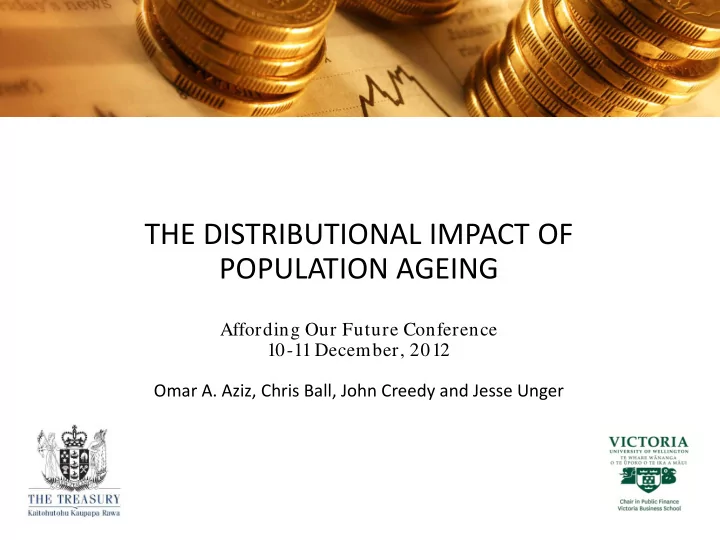

THE DISTRIBUTIONAL IMPACT OF POPULATION AGEING Affording Our Future Conference 10-11 December, 2012 Omar A. Aziz, Chris Ball, John Creedy and Jesse Unger
LIVING STANDARDS: THE HEART OF OUR POLICY ADVICE Assess the impact of policy across key living standards dimensions Economic Growth Sustainability HIGHER LIVING Reducing for the STANDARDS Risks Future • FINANCIAL AND PHYSICAL CAPITAL • NATURAL CAPITAL • SOCIAL CAPITAL • HUMAN CAPITAL Intra-generational income inequality Social Increasing Infrastructure Equity Inter-generational equity
CENTRAL QUESTIONS What impact does population ageing have on: 1. Income inequality 2. The incidence of tax and spending by age-groups
INCOME DISTRIBUTION Possible determinants: Policy settings / changes Demographic change Skills Technology Globalisation Household formation rates Labour Market Participation ...and possibly many others...
INCOME DISTRIBUTION Possible determinants: Policy settings / changes Demographic change Skills Why? Technology Two most important Globalisation assumptions of the LTFM Household formation rates Labour Market Participation ...and possibly many others...
Age Groups as a Proportion of Total Population (LTFS Assumption)
Labour Force Participation by Age (LTFS Assumption)
FRAMEWORK FOR ANALYSIS Data: Household Economic Survey (HES) 2009/10 Isolate the impact of population ageing and LFP... ...on the income distribution Same number 2010 (base year) of people as in Different mix of 2010 age-groups 2020 i.e. 2030 And 2040 Total population 2050 Labour Force constant at 2060 Participation approx. 4.2 million...
Median Market Income by Age-Group: 2010 Peak Earning Years Relatively Low Market Incomes
Proportion of Older Age-Groups by Income Decile Predominantly ages 80+ Predominantly ages 65 - 79
Wages and salaries, investments, Market income self-employment Income Support Working-age Benefits + Redistribution Working for Families NZ Super _ Housing Subsidies Direct Tax Cash-in-hand Disposable Income $-Value of In-Kind Social Services + Redistribution Health _ Education Indirect Tax GST Excise Income measure of Final Income economic well-being of individuals / households
Gini Coefficients by Income Type
Percentage Change in Gini Measure Across Incomes Year Market to Disposable Disposable to Final 2010 -31% -9% 2020 -32% -10% 2030 -33% -11% 2040 -34% -11% 2050 -34% -12% 2060 -35% -12%
AGE-INCIDENCE OF TAX AND SPENDING What impact does population ageing have on the distribution of tax and spending across age-groups?
AGE-INCIDENCE OF TAX AND SPENDING TAXES Direct and Indirect Taxes (GST, Excises) SPENDING Welfare (core benefits, WfF, supplementary payments) Excludes NZS Defence Health Justice Transport Housing (AS, IRR) Arts/Culture etc. Education (ECE, Primary, Secondary, Tertiary)
NET FISCAL IMPACT
NET FISCAL IMPACT
YEAR NET FISCAL IMPACT (Billions) 2010 -$8 2020 -$8 2030 -$11 2040 -$13 2050 -$13 2060 -$15
LIVING STANDARDS: THE HEART OF OUR POLICY ADVICE Assess the impact of policy across key living standards dimensions Economic Growth Sustainability HIGHER LIVING Reducing for the STANDARDS Risks Future • FINANCIAL AND PHYSICAL CAPITAL • NATURAL CAPITAL • SOCIAL CAPITAL • HUMAN CAPITAL Intra-generational income inequality Social Increasing Infrastructure Equity Inter-generational equity
Gini Coefficients by Income Type YEAR NET FISCAL IMPACT (Billions) Contribution to gap 2010 -$8 in a single year 2020 -$8 2030 -$11 Cumulatively 2040 -$13 around 5% of GDP by 2060 2050 -$13 2060 -$15
Gini Coefficients by Income Type Redistributive YEAR NET FISCAL IMPACT (Billions) policies... 2010 -$8 at a point in time... 2020 -$8 2030 -$11 will be increasingly 2040 -$13 funded by debt 2050 -$13 2060 -$15
POLICY RESPONSE TO GROWING FISCAL GAP Fiscal Gap: X% of GDP 2010 2020 2040 2060 Policy response Any policy choice to close the fiscal gap will have distributional consequences... Both income inequality and inter-generational equity will be affected by a policy response but... ...we can moderate the extent to which this happens
TWO TYPES OF POLICY RESPONSES Fiscal Gap: X% of GDP 2010 2020 2040 2060 Policy response Two extreme response scenarios: 1. Short n sharp: consequences for intra-generational income inequality, poverty etc; inter-generational equity less of a concern 2. Gradual changes over long time horizon: intra-generational income inequality may not be affected; consequences for inter-generational equity over transition period
TWO TYPES OF POLICY RESPONSES Fiscal Gap: X% of GDP 2010 2020 2040 2060 Policy response Two extreme response scenarios: 1. Short n sharp: consequences for intra-generational income inequality, poverty etc; inter-generational equity less of a concern 2. Gradual changes over long time horizon: intra-generational income inequality may not be affected; consequences for inter-generational equity over transition period
INEQUALITY AND EQUITY Interaction Intra-generational Inter-generational Income Inequality Equity Policy can be used to moderate this interaction
SUMMARY Change in composition of income distribution - “who ends up where” Lower-end dominated by superannuitants Inequality in distribution of market income Stable distribution of disposable / final income More generous cash and in-kind transfers to the lower-end
SUMMARY Timing and duration of response to fiscal challenges has important distributional consequences Policy can be used to moderate the effects of the response on inequality and inter-generational equity Great value judgements involved... Agreement on a course of action will require much public debate
QUESTIONS
Recommend
More recommend